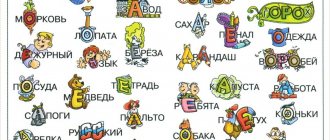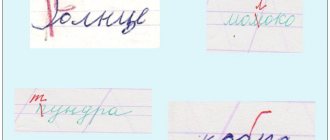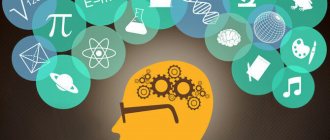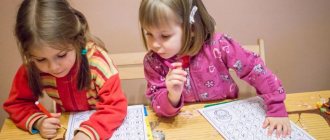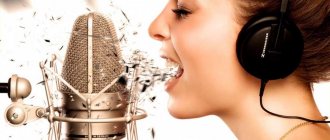Definition
Mnemonics (mnemonics) is a list of methods and techniques that help remember various types of information.
Mnemonics is based on the principle of visualizing abstract objects, which are replaced by specific concepts or figurative definitions. To easily and quickly memorize the necessary information, you need to associatively associate it with some visual idea, sound image or sensation. Associations - establishing connections with known images and phenomena.
Mnemonic tables for children with OHP
The concept of coherent speech and its significance for the development of a child with general speech underdevelopment (GSD) has a direct relationship with the logic of thinking and the ability to comprehend images seen or sounds heard, expressing this in sequential speech in which logical chains are present. The general level of development of coherent speech inherent in preschoolers with ODD depends on the ability to think through information and construct statements on a variety of topics.
Dialogical speech is displayed in the communication of several people, often accompanied by simple monosyllabic statements, asking specific questions and composing options for answers to the interlocutor’s questions, followed by reproduction of the selected answer. In this process, a special role is played by formulating and asking questions, constructing answers and reasoned defense of one’s opinion. Coherent monologue speech in preschoolers is characterized by expansion and concentration of thoughts on the main thing, without delving into details. In the process of reproducing one’s thoughts and choosing linguistic means, internal motives play a decisive role, since it is they that stimulate monologue speech.
The features of the stages of development of coherent monologue and dialogic speech vary, but both types are closely interrelated. This nuance must be taken into account when conducting classes aimed at stimulating the development of coherent speech in children with ODD.
The introduction of mnemonics into speech development classes for preschool children should be carried out with the help of mnemonic squares, in which the simplest words are encrypted (boy, girl, sun). Only after children understand the concept of “encryption” can they move on to more difficult variants of schemes - mnemonic tracks with mnemonic tables, which can be based on a whole story.
Mnemonic track “Two funny geese”.
Using this technique during classes with children with special needs allows:
- increase attention and interest in games with logic cards;
- facilitate the perception and processing of information data that
- are stored in memory and can be played back if necessary.
Mnemonics for children
Over the past few decades, this innovative direction in pedagogy and speech therapy has become popular. Kindergarten teachers began to pay more attention and time to speech development.
Classes are held in groups where children get acquainted with works of art, poetry, and fairy tales. It is especially useful to memorize poems and read them with expression. This trains memory, shapes speech, and enriches vocabulary.
Expressiveness of performance develops speech technique - diction, breathing. To do this, special exercises are carried out to help develop speech hearing and clear pronunciation of sounds and words. Also, the educational program of the preschool educational institution includes classes on mnemonics.
From what age is it used?
Teaching children using mnemonics can begin from a very early age. Getting to know exercises for children starts with simple techniques.
First, they use mnemonic squares, which can be introduced to children at the age of three. In the first lessons, children study simple images that represent one word, phrase or simple phrase. You can place pictures in a square and learn poems with movements.
Later, at 4-5 years old, children become familiar with mnemonic tracks - systematized pictures of four drawings. With the help of such images, the concept of sequences is formed. Thanks to group illustrations, you can easily tell a short story, remember the steps of washing your hands, the process of dressing or washing your face.
Children aged 6-7 years begin to study mnemonic tables that allow them to perform more complex actions:
- retell various works;
- memorize poems and complex words;
- guess and make riddles;
- find rhymes for words;
- invent fairy tales or stories;
- distribute objects into groups according to certain characteristics;
- study numbers;
- become familiar with the basic rules of life safety and behavior in various places, and methods of self-service.
Children learn to express their thoughts correctly and beautifully and use new words in speech. Attention and intelligence develop, the ability to highlight the main thing and compare improves.
Mnemonic techniques
- Eidotehnika (eido - image) - representation of an object outside the zone of perception, i.e. application of imaginative thinking. The exercise is aimed at creating images, objects, and natural phenomena.
- Associative chain technique . Words are connected in order, one after another, without skipping. The result is a story or fairy tale. In this game, children quickly remember a chain of words.
- The Cicero method is the placement of information in space. The essence of the method is the imaginary placement of images in a specific place.
- Method of transformation (transformation). Exercise promotes the development of memory and logical thinking. The words seem to flow from one another, something unites them.
- Support method (numeric-letter method). Children remember information by associating the meaning of certain words, sounds and numbers.
- “Croqueting” technique (from the French word croquis - drawing, sketch). Method of graphic associations. The essence is to recode the information received when drawing objects and natural phenomena.
Mnemonic table, mnemonic square, mnemonic track, collage - these are the teaching tools of the crocheting method.
Mnemonic tables are images containing information. They reduce learning time and at the same time develop memory, attention, and creative thinking. Help transform abstract images into concrete objects.
A mnemonic square is a card with an image of encoded information.
Mnemonic track is a sequential distribution of mnemonic squares according to which the child composes a story.
Collages are aids that perform the following tasks:
- teach (thematic collages);
- remember;
- form the skill of attention distribution.
Pros and cons of mnemonics
Mnemonics are actively used in teaching children. For example, one of the most famous phrases for studying the sequence in the color spectrum is “Every Hunter Wants to Know Where the Pheasant Sits.” It is she who helps to accurately tell how a rainbow “works.”
The role of methodology in the development of children:
- helps you remember information quickly and for a long time;
- improves memory and attentiveness;
- develops speech, expands vocabulary and horizons, teaches how to pronounce sounds and words correctly;
- forms logical and imaginative thinking;
- improves imagination, intellectual and creative abilities;
- develops character, teaches sociability, helps to overcome isolation and shyness.
When used correctly, mnemonics have very few disadvantages.
- At the initial stage of use, children have a small vocabulary, so it can be difficult for them to work using this method.
- There is no need to abuse the method and use it in cases where it is too easy to understand the properties and remember the signs - this hinders the child’s development.
- Sometimes it is not possible to use the technique. For all-round development, it is necessary to teach the child to learn information mechanically; this skill will also be useful in the future.
The human brain consists of two hemispheres. The left is responsible for logic and speech, and the right helps to perceive different colors and form images using the imagination. When using mnemonic techniques, both halves are activated simultaneously. As a result, thought processes bring maximum benefit in the form of acquired knowledge.
Exercises for preschoolers
Preschool age is considered a favorable period for laying the foundations of competent, clear, beautiful speech. Mnemonics for beginners (simple, fun tasks, games) will help your child’s speech develop faster. It is useful for the development of the articulatory apparatus to perform tasks using onomatopoeic words. They correct diction well - pure jokes (“If only there was smoke coming out of the chimney”), nursery rhymes, phrases containing a certain group of sounds (“Sanya’s sleigh rides on its own”).
Exercises on the pronunciation of hissing sounds can be combined thematically.
After looking at the picture “Hedgehog and Hedgehogs,” the adult offers to complete a number of tasks. The child must clearly pronounce phrases with the sounds “sh” and “zh”. “Sha-sha-sha - we walk slowly; shu-shu-shu - I’ll give the baby a raspberry; shi-shi-shi - where the kids walk.” Such exercises help you master question intonation and develop a sense of rhythm.
By isolating the sound while clearly pronouncing a word, the skill of understanding the terminology “sound” and “word” is developed. When working with children, it is necessary to emphasize the development of intonation sense, rate of speech, diction, and strength of voice. Games can help with this.
Exercises for beginners:
- "Whose voice is this ? The goal of the game is for the child to learn to recognize adult animals from young animals by the reproduced sound. For such a game, you can take figurines of a dog and a puppy, a duck and a duckling, a cat and a kitten. Alternatively, you can sculpt animals from plasticine or use cards. The plot of the game: animals come to visit the baby, they want to play with him. Children should understand the difference between how a mother cat meows and how her baby meows.
- Game "Compare the cubes" . The task is to teach the child to correlate objects with different characteristics. An adult offers to look at two cubes and tell how they differ. The kid takes one cube and says that it is big, and the second cube is small. The first cube is red and the second is white. The red cube is plastic, the white cube is made of fabric and is soft inside.
- Game “Compare two kittens” . The child is asked to look at the kittens. One of them is white and large, and the second is black and smaller. You need to say who they are. Come up with names for them so that it is clear that one kitten is black and the other is white. What is the difference.
- Game “What little animals can do . The goal of the game is to choose verbs that denote the characteristic actions of animals. An adult shows pictures of animals, and the child must say what they can do or what they say. For example, a cat loves mice. She loves to meow. The dog loves to bark and eat bones, run and jump. The cockerel crows and loves to peck grains.
- Game "Profession" . Here you will need cards that depict people of different professions (pilot, hairdresser, doctor, cook). An adult asks who heals people. The kid must answer correctly. This is how the remaining cards are played.
- The game “Wizards” helps expand vocabulary, develops long-term memory and logical thinking. You will need cards with images of individual objects - a table, an apple, a door. The adult names several words, and the child must choose those cards that will help him remember the named words. He kind of “bewitches” them into these cards. Then the baby takes the cards and with their help remembers the named words. The game is aimed at understanding the logical connections between objects.
Regular playful activities help to awaken interest in words. The exercises prepare children for further independent compilation of narratives, stories, texts, and form connected speech.
How to create a mnemonic table yourself?
When working with your little one, you can use both ready-made mnemonic tables and ones you make yourself. In order to make a table based on a poem or story, you need:
- Divide the text into fragments (the younger the child, the shorter).
- Draw squares on a piece of paper according to the number of text fragments.
- In each square, depict what is said in the fragment, or what is associated with it. A child of senior preschool age can independently draw pictures for the table.
- If you wish, you can sign the text in each square that you need to remember.
Rules for conducting classes
The process of working and learning with children should be comfortable and beneficial.
- You need to start with simple tasks. First, you can look at cards with single images.
- You should not immediately overload your preschooler; he will quickly get tired and will not absorb the information. You can show no more than two mnemonic tables per day.
- All images of didactic material must be bright and colorful. Children quickly remember colorful images. The grass is green, the carrot is orange, the pine cone is brown, the sea is blue.
- It is worth changing the topic of the lesson every time, otherwise the child will lose interest. Today we are learning poetry. Tomorrow - a fairy tale, wild animals, etc.
- It is important that classes take place only in a playful way.
Areas of use of mnemonic tables
Mnemonic tables for the formation and development of coherent speech (developmental and educational) are images of textual information that is previously divided into groups of words in sequential order. There is one illustration for each group of words. Thanks to such a schematic sketch of information, the baby easily perceives it, remembering everything without much effort.
Using mnemonic tables for speech development, the following is carried out:
- Memorizing fairy tales or rhymes. Young children take part with great interest in educational games based on fairy tales they know. At home, you can invite your child to tell a story to his favorite toy, using a series of pictures. You can also draw a mnemonic table together, depicting the heroes of events with your own invented symbols, for example, a triangle is a person, a wavy line is a cloud in the sky. Thus, not only the formation of coherent speech occurs, but also the active development of imagination and fantasy with the manifestation of the hidden creative abilities of children.
- Learning general rules, such as how to brush your teeth correctly. The diagrams depict the sequence of all manipulations that are easily perceived and remembered.
- Compiling stories describing objects, events, pets, etc. Focusing on pictures that answer basic questions: who is it, what color is it, what sounds does it make, what does it like to eat, etc., children can create a consistent description.
- Working on a retelling. After reading the text, the most difficult words are highlighted, the meaning of which must be explained to the child. After the explanations, a conversation should be held on the entire content of the text with a demonstration of drawings from the mnemonic table. A joint retelling using pictures will allow the child to quickly remember information and tell the story he heard himself.
- Solving riddles. With the help of mnemonic tables, children learn to identify an exact object, focusing on its characteristics. At the first stage, it is necessary to explain to the child everything that is depicted in each picture, and only after that offer to independently guess the encrypted object.
Speech therapy classes on the development of coherent speech using a variety of mnemonic diagrams involve memorizing and deciphering the plot illustrations given in the table. The type and thematic content of mnemonic tables can be different; execution can be printed (Doman cards) or made by hand. Cards for speech development in the first lessons should be small with light storylines; it is recommended to place 3-4 of them in one row, in this position they are easier to perceive.
Homeschooling with mnemonic tables
These benefits are suitable for working independently or with parents. There are developments on various subjects and topics. It is worth using tables as a didactic game to explain an incomprehensible phenomenon to a child.
Mnemonics and children's perception of the world
Visual-figurative perception of the world helps children actively assimilate the visible characteristics of objects. Having difficulty understanding them together, children enthusiastically highlight individual bright components. Visuals entertain and hold attention. Children, while playing, learn the material.
Mnemonic tables for preschoolers are an exciting game.
Mnemonic tables for development, knowledge of the world
When developing tables, remember the principles:
- to attract attention;
- recognition of images;
- variety of topics;
- It is forbidden to overload with quantity (up to 9 images).
Card index of mnemonic diagrams for compiling descriptive stories
Theme "Household Appliances"
Purpose: to analyze the shape, purpose, material, design of devices.
Possible table contents: name, color, shape, material, details, application.
Theme "Spring"
Goal: analyze the weather, animal habits, clothing, human behavior.
Possible content: weather, clothing, labor, birds, animals, fun.
